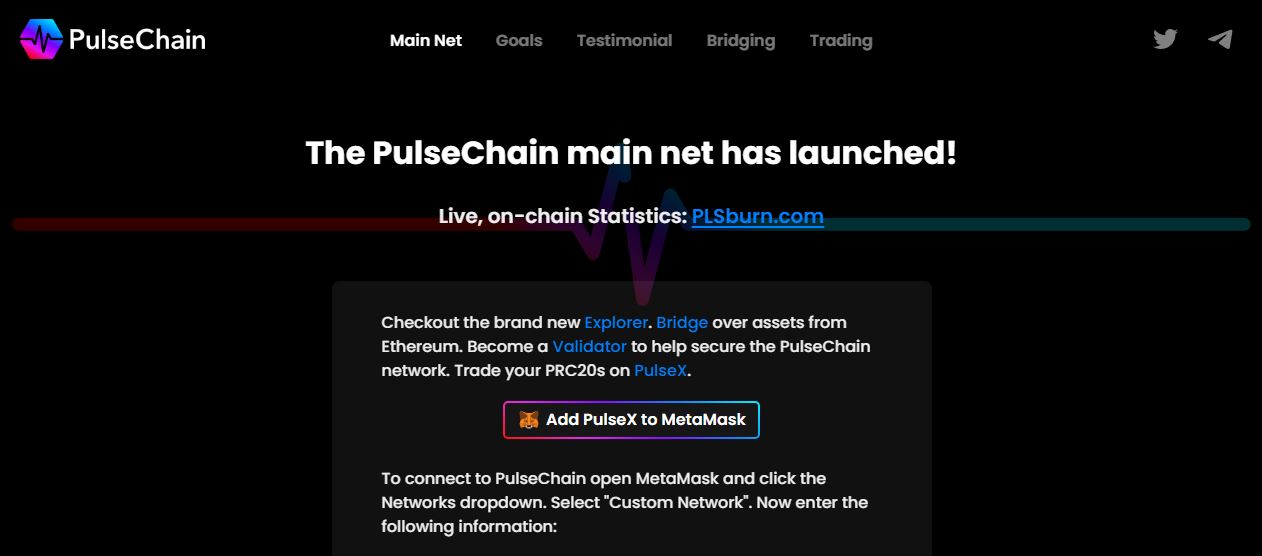PulseChain Has Launched
The PulseChain Launch
The PulseChain launch refers to the release of the PulseChain mainnet, which occurred on May 13, 2023 [3][4]. PulseChain is a blockchain project led by Richard Heart of Hex fame, and is considered one of the most anticipated blockchain launches ever [8]. It is designed as an Ethereum network fork and aims to provide a scalable and low-cost environment for decentralized applications (DApps) and token transactions [1].
During the launch, a significant amount of tokens were burnt, with reports indicating that 3 billion tokens were burned within the first 12 hours [3]. This burning process involves removing tokens from circulation, which can potentially impact the token’s value and scarcity.
The launch of PulseChain also involved an airdrop, which is considered the largest in history [1]. Thousands of Ethereum-based tokens and non-fungible tokens (NFTs) received their free versions on the PulseChain network, allowing users to explore and discover the value of these tokens and NFTs on the new platform.
In preparation for the mainnet launch, PulseChain had several testnet versions (testnet v1 to v4) available for users to explore and get acquainted with the network [2]. The testnets allowed users to experience various features and options offered by the PulseChain network, such as using the PulseChain explorer and exploring blocks [2].
Overall, the PulseChain launch has generated significant interest and excitement within the Web3 community, and its success in terms of token burning and airdrop participation indicates a positive start for the project [3][6]. Users interested in participating or learning more about PulseChain can visit their official website and explore the provided resources [1].
What are the advantages of the new Pulsechain blockchain?
The new PulseChain blockchain offers several advantages that set it apart from other blockchain platforms.
Here are some of the key advantages of PulseChain:
- Scalability: PulseChain aims to address the scalability issues faced by the Ethereum network. It achieves this by implementing various optimizations and improvements, allowing for faster and more efficient transaction processing.
- Lower Transaction Fees: High transaction fees have been a concern on the Ethereum network. PulseChain aims to provide a low-cost environment for transactions, making it more affordable for users to interact with decentralized applications (DApps) and transfer tokens.
- Interoperability: PulseChain is designed as a fork of the Ethereum network, which means it retains compatibility with Ethereum-based tokens and smart contracts. This interoperability allows seamless integration and interaction with existing Ethereum ecosystem projects.
- Airdrop and Value Discovery: As part of the PulseChain launch, there was a significant airdrop of Ethereum-based tokens and NFTs to their PulseChain versions. This airdrop provides an opportunity for users to discover and explore the value of various tokens and NFTs on the PulseChain network.
- Community-driven: PulseChain has gained a considerable following and community support. The project has generated anticipation and excitement within the Web3 community, which can lead to increased adoption and development of projects on the platform.
- Enhanced Security: PulseChain benefits from the security features inherent in blockchain technology, such as decentralization, immutability, and cryptographic verification. These features contribute to a secure and tamper-resistant environment for conducting transactions and executing smart contracts.
- Developer-Friendly: PulseChain aims to provide a developer-friendly ecosystem, allowing developers to build and deploy decentralized applications (DApps) with ease. The compatibility with Ethereum tooling and existing developer expertise enables a smoother transition and development experience.
How does Pulsechain compare to the Bitcoin and Ethereum blockchains?
PulseChain, Bitcoin, and Ethereum are all blockchain platforms but differ in various aspects. Here’s a comparison of PulseChain with Bitcoin and Ethereum:
- Scalability: Bitcoin and Ethereum have faced scalability challenges, resulting in high transaction fees and slower transaction processing times during peak periods. PulseChain aims to address these scalability issues by implementing optimizations for faster and more efficient transaction processing, potentially offering lower transaction fees and improved scalability.
- Purpose: Bitcoin was created as a decentralized digital currency, primarily serving as a store of value and a medium of exchange. Ethereum, on the other hand, is a programmable blockchain platform that enables the development of smart contracts and decentralized applications (DApps). PulseChain, as a fork of Ethereum, inherits the programmability and DApp development capabilities of Ethereum.
- Interoperability: While Bitcoin and Ethereum have their respective ecosystems, PulseChain is designed as a fork of Ethereum, ensuring compatibility with Ethereum-based tokens, smart contracts, and existing projects. This interoperability allows for seamless integration and interaction with the Ethereum ecosystem.
- Tokenomics: Bitcoin operates on its native cryptocurrency, BTC, which serves as a digital currency and a store of value. Ethereum’s native cryptocurrency is Ether (ETH), used for gas fees and as a means of exchange within the Ethereum network. PulseChain has its native token called PULSE (PLS), which serves similar functions within the PulseChain ecosystem.
- Community and Adoption: Bitcoin has established itself as the pioneering and most widely recognized cryptocurrency, with a large and dedicated community of supporters and investors. Ethereum has gained significant adoption due to its smart contract capabilities, supporting a vibrant ecosystem of DApps, decentralized finance (DeFi) projects, and non-fungible tokens (NFTs). PulseChain, being a relatively new project, has generated anticipation and interest within the Web3 community.
- Development and Innovation: Ethereum has been at the forefront of blockchain innovation, providing a platform for developers to create and deploy various decentralized applications, including DeFi protocols, NFT marketplaces, and more. PulseChain, being a fork of Ethereum, inherits the potential for innovation and development on its platform. Bitcoin, while it has seen some improvements and innovations, is primarily focused on maintaining its role as a decentralized digital currency.
References: [1] PulseChain – The Largest Airdrop in History [2] How to Get Started with PulseChain (PLS) Mainnet Launch Prep [3] Pulsechain (PLS) Launch: Everything You Need to Know [4] What is PulseChain? When Will the Mainnet be Launched? [5] Where to Buy PulseChain (PLS) Crypto [6] From Hex to PLS: PulseChain’s Launch Puts Richard Heart’s Tokens in the Spotlight [7] PulseChain Launch: Everything You Need to Know [8] What Could Happen on Day 1 When PulseChain is Launched? [9] Pulsefinity Launchpad Takes Off on PulseChain


